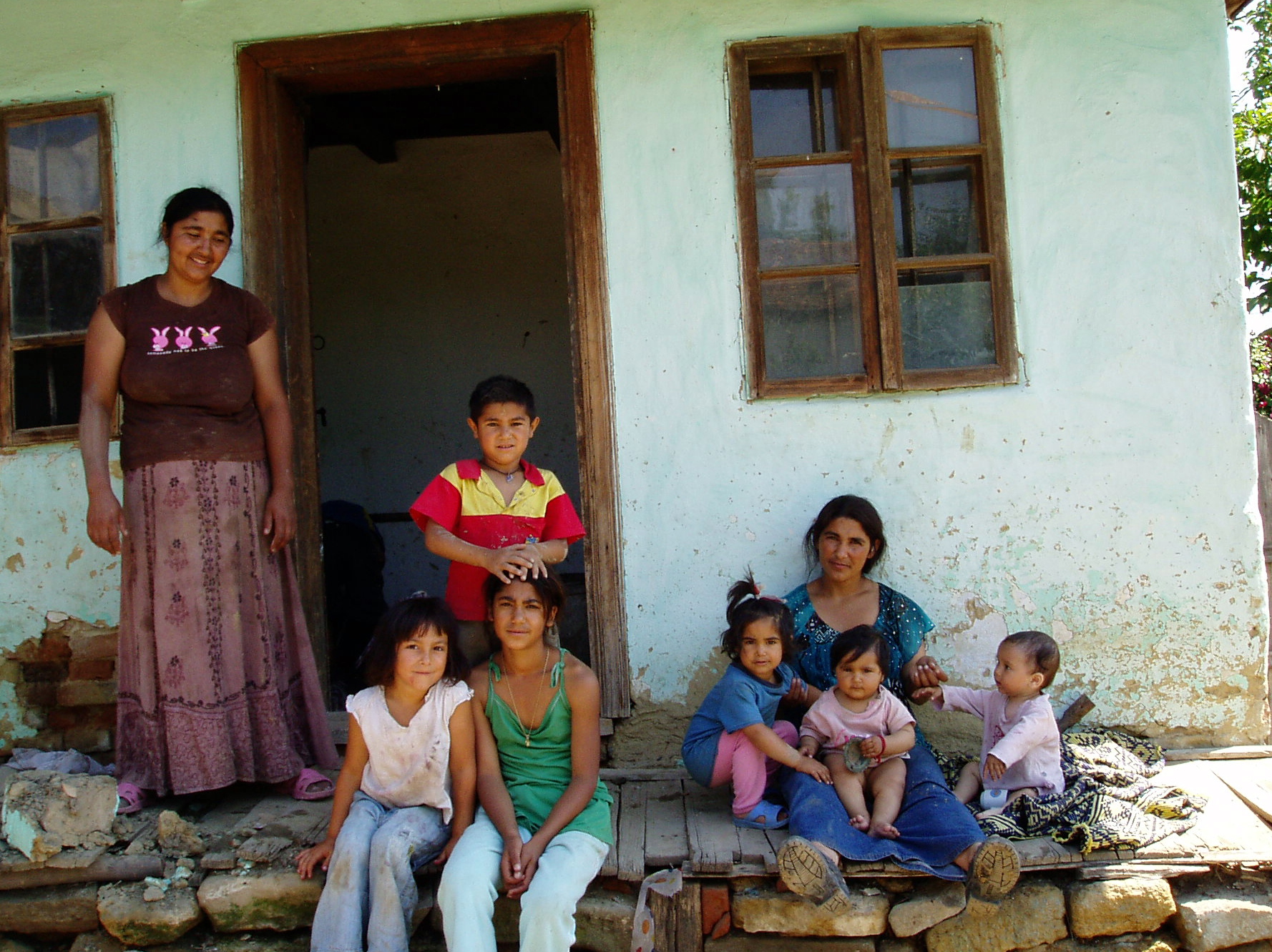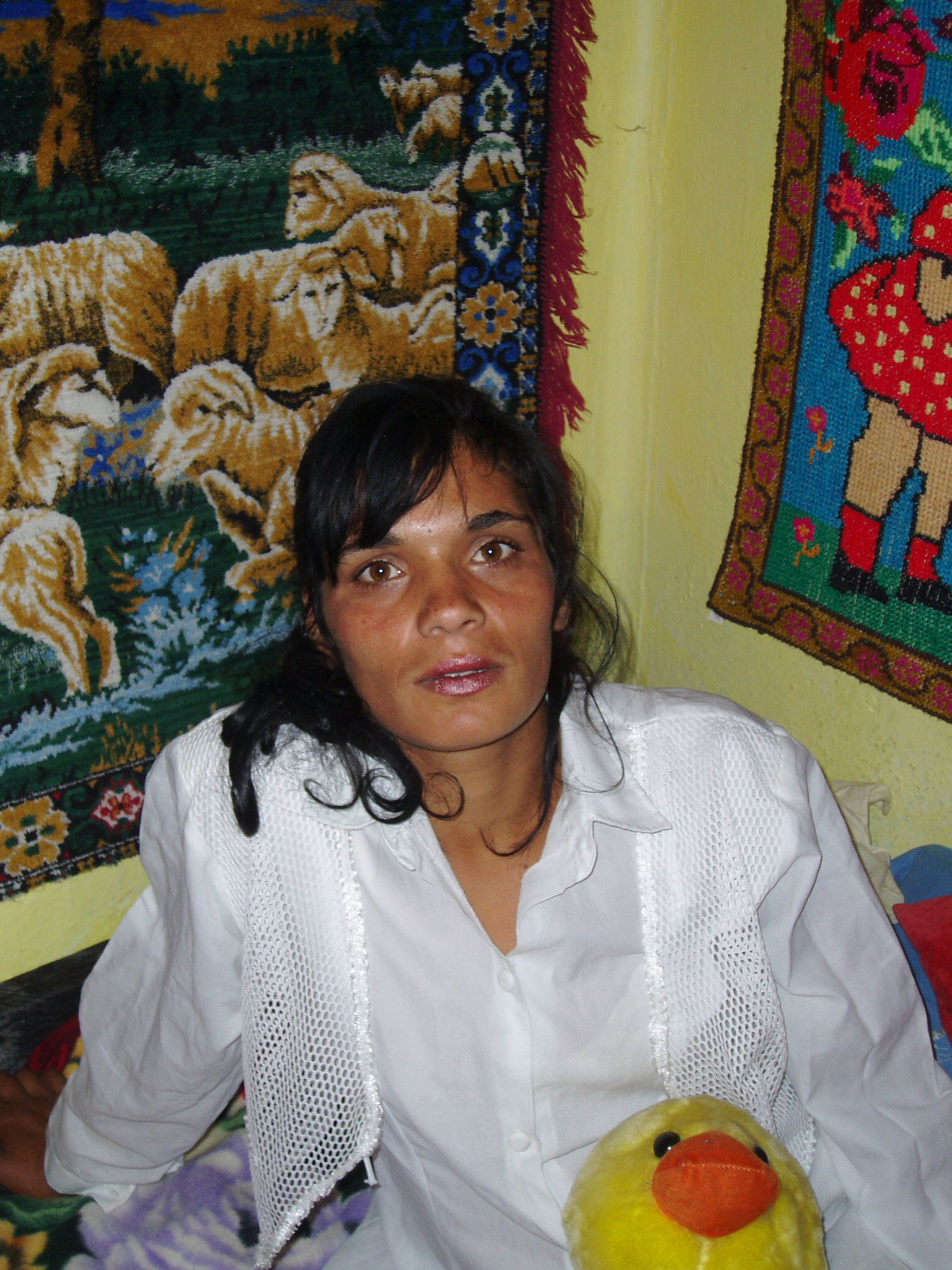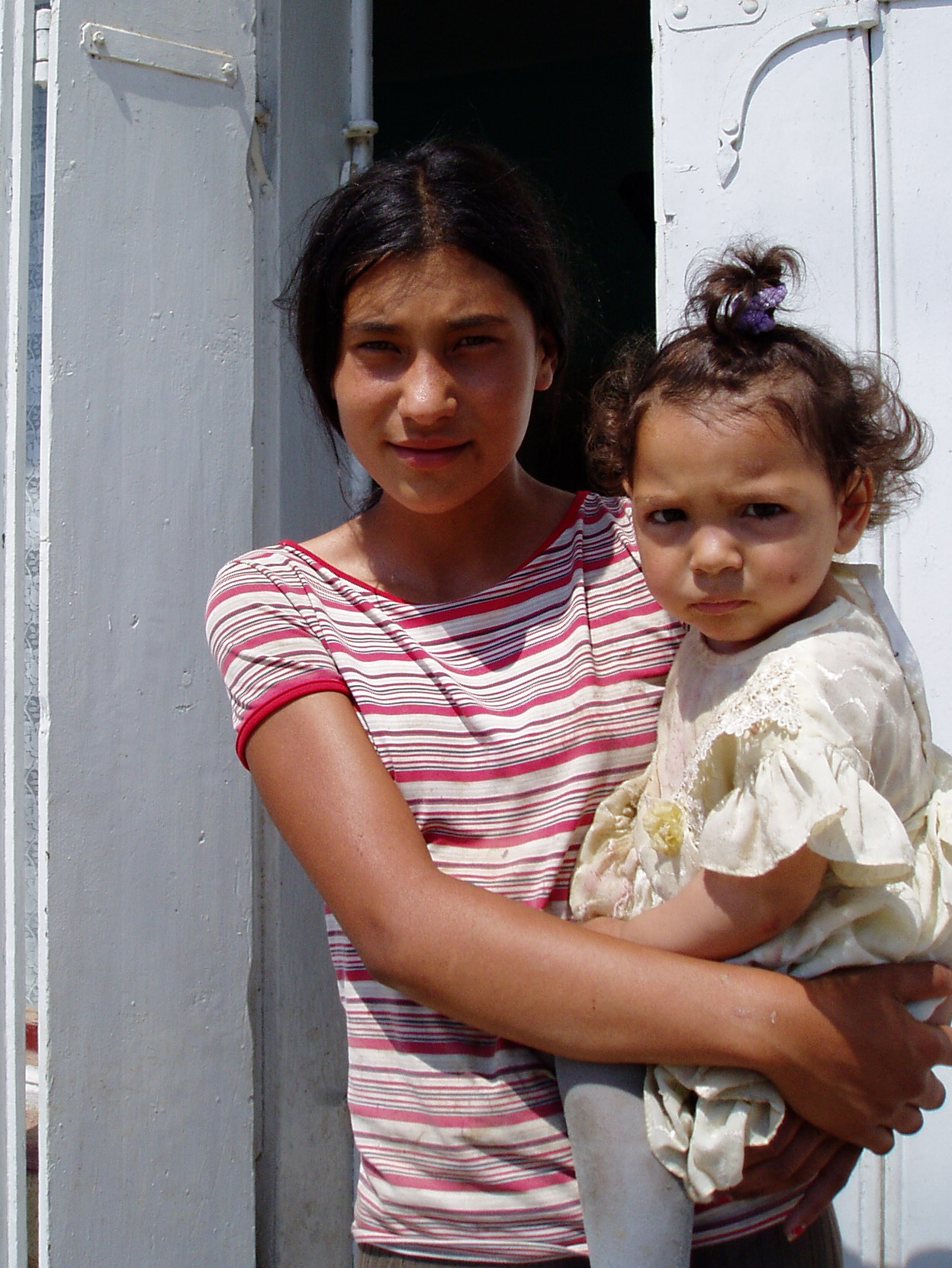(Featured image: Roma trash collectors and scavenging crows at landfill in Pata Rat Cluj, Romania. Courtesy Chuck Todaro, all rights reserved)
By Chuck Todaro, written on behalf of the Tzigania Project
“Get out of here you crows” is something you might hear bellowing out the door of the Village Hall over a crowd of Gypsies jostling for attention. Crow, “ciora” in Romanian, is one in a long list of ethnic slurs attributed to the Romani people. It’s a disparaging slur that should not be used by non-Gypsies – a psychologist might attribute its use to low self-esteem and an attempt at raising it by stepping over others – yet little does the loudmouth know that a literal view of the association between Romani and crows is really quite “mishto,” or “cool” in the Gypsy tongue.

Crows learn to crack nuts by leaving them on the road for cars to run over (photo credit: hedera.baltica, used under CC BY-SA 2.0)
I first became interested in crows by watching them dodge speeding cars while feeding off roadside casualties. It struck me odd that I had come across plenty of splattered frogs, flattened raccoons, odorous dead skunks, disemboweled cats and dogs, a variety of birds caught in the radiator grill, and sadly even a few humans – but never, not once, had I passed a rundown crow; these birds clearly had brains.
That’s not just my opinion; ornithologists studying the black bird have been steadily coming out with new research proving Corvus, the genus of crows and ravens, possess the ability to use and even make tools, placing them into that exclusive club once reserved only for humans and chimpanzees. Their advanced social skills form a community which shares information and works together. “Never a dead crow on the side of the road” can be attributed to the designated lookout of the flock standing guard during dangerous moments cawing “heads up!”
Crows’ deep rooted sense of “brotherhood,” and how it nurtures the way they feed, play, nest and protect, just so happen to be the fundamentals of Gypsy society. It contrasts with modern man’s increasingly common “every man for himself” mantra, a trait shared with those other species found flattened and disemboweled by cars in the gutter.
These bonds form within the comradery and support network provided both in the crows’ nests and the Gypsies’ traditionally large families, who yet share a single house. Both Roma and crow display an undying devotion to their families. Crows mate for life while offspring remain with the family unit helping to raise siblings for up to five years, a quarter of their average lifespan; it’s a stable family unit up there in the trees. Crow roosts can grow to be enormous, some containing up to 100,000 birds. Similarly, the socially bonded neighborhoods of “tzigania” (Gypsy communities), numbering anywhere between 10 and 3,000 people, form a related community that both understands and practices the aphorism “a twig is easily broken while a bundle resists.” Gypsies and crows alike stick together like glue.
“Father made everything from bits and pieces of material he collected,” Gaby Gabor, an ethnic Roma explains, pointing to the workshop’s accumulation of metal shaping machines. “He didn’t buy a thing. He built everything from parts people were throwing out.” The Gabor family metalworking business has been supporting two Roma families and several village employees for over 25 years.
Nomadic Roma’s ancestral hunter-gatherer lifestyle is alive and well in routinely “seeking out value in what others deem worthless”. “That’s the Gypsy way” claims Gheorghe Coman from the Gila suburb of Bucharest. “I’ll tell you what a Gypsy is; a Gypsy is a man who picks up bits and pieces of wood on his walk home so he can cook his dinner”. It’s such scavenging which helped develop the brain’s creativity sensors, making the crow “smart” and the Gypsy “crafty”, as they are often labeled. It’s been an inconspicuous part of their daily life for centuries, every once and a while making headlines as in the mysterious coat hanger robberies of Tokyo. The local authorities were scratching their heads wondering who was behind this bizarre wave of thefts until suddenly the goods were spotted high above in the trees, having become the popular new building material framing crows’ nests.
It was scavenging that drew the opportunistic crow to early man’s campfires, and who like the wolf has been shadowing man’s ascent ever since. While the wolf evolved into the dog, the free-spirited crow kept in sight yet still out of reach. The glistening black plumage of its ominous perch, together with its echoing caws between the members of its group (or “murder”), made a haunting impact. The bird transcended from one-dimensional Paleolithic cave paintings into metaphysical mythology – as “messengers to the gods”, “bearers of good luck”, or “omens” – and was finally immortalized by the likes of Shakespeare and the master of the macabre Edgar Allan Poe.
And the Raven, never flitting, still is sitting, still is sitting
On the pallid bust of Pallas just above my chamber door;
And his eyes have all the seeming of a demon’s that is dreaming,
And the lamp-light o’er him streaming throws his shadow on the floor;
And my soul from out that shadow that lies floating on the floor
Shall be lifted—nevermore!
The second half of the Gypsy-crow relationship concerns their common stereotypes. Crow and Gypsy both share a long, common history as a scapegoat. The crow and related raven stand out from among the other harmonious, colorful bird beauties we see dashing between trees – the flashy red cardinal, majestic blue jay and gracious swan – rather appearing “black as coal” from beak to claw. It made an impact just as had the dark, swarthy complexions of the first Gypsies in Europe, who came from northwest India fleeing Islamic invasion. That’s what people most noticed and then talked about. The early records, beginning in the late 12th century, are loaded with color references: Gypsies were “poor folk like the Ethiopians, black and ungainly”, “terrible to look at… black like the tartars”, “the women were the ugliest you ever saw and the darkest, all with scarred faces and hair as black as a horse’s tail”[1] – and so on.
Black has always been a color with a presence – and one that since Roman times has been associated with death. Since “white” has been the mark of purity, holiness, the graces of God, all that’s good in man’s eternal yin-yang conflict, the color “black” has been left with the burden of representing all that’s evil and demonic, like witches and magic, giving the passing crow and arriving Gypsy an immediate shadowy reputation even before they opened their mouths.
Like the crow with its loud reverberating caw, Gypsies too would loudly advertise their mysticism with “snakes wound around them… telling one person that he was born under an evil star, and the other under a lucky star.” It was good business. Intuitive Gypsy women found a lucrative niche between the intangible “faith” sold by the church and limited knowledge offered by science. “You never saw greater crowds going to the Lendit benediction than went flocking to La Chappelle to see them [Gypsies] while they were there… indeed, their children were very, very clever, both the girls and the boys. Most of them – almost all of them – had their ears pierced… they had sorceresses among them who looked at people’s hands and told them what had happened to them or what would happen…”[2]
Finding scapegoats was a popular practice back in the time of the arriving Gypsy refugees. When disasters struck like war, famine and disease and blame needed to be diverted, an easy target with no recourse was found in the alien Gypsies. “Dirty and diseased”, “carriers of the plague”, “treacherous spies” and “cannibals” were just a few of the accusations. White European parents found Gypsies’ swarthy appearances useful in the ceaseless battle of getting their children to behave, labeling the Gypsies as the “boogie man”. “Behave or the Gypsy will come and take you” they warned, leaving children all alone in the darkness of their bedroom with haunting images of the black handed Gypsy slithering in through the open window and hiding under their bed. The horror imbedded itself into the child’s subconscious to later reemerge, which it did, again, quite recently in response to accusations that Gypsies had kidnapped a blond white girl. It struck a nerve, and the media ran all sorts of shocking headlines: “An Angel Kidnapped by Gypsies?” (UK Guardian) and “Shock as Blue Eyed Girl Discovered with Second Roma Family” (UK Daily Star).
(It was later proven that the child was given to the family willingly, and the kidnapping charges were dropped. Rushes to judgment are common in cases involving Roma.)
Nonetheless, white Europeans’ relationship to the Gypsy and crow wasn’t all gloom and doom. It had ups and downs with differing perceptions, though less between countries than between classes. The aristocratic rich and powerful gauged the crow’s mystical links to the gods as something better to be “with” than “against”, making the bird a part of their propaganda by featuring it on their war banners, armor and family crests – a practice carried on today in the sports arenas, where Ravens battle against Saints, Chiefs, Titans and Giants. The crow became a sign of respectability as a chosen surname: Italian “Corvi”, French “Corbin”, Spanish “Cuervo”, Irish-British “Crowe”, and the most famous, Matthias Corvinus, the King of Hungary.
While noblemen sitting comfortably in their castles glorified the mystical bird, the peasantry were crying “thief”. Rather than statues, farmers were building scarecrows and killing machines. In the Middle East crows were linked with the rat, kite, scorpion and rabid dog as creatures permissible to kill. In the 1940s – 50s USA, open hunting season was ordered on public enemy #1, “the black bandit”; roosts were laid with dynamite killing thousands in a single blast.
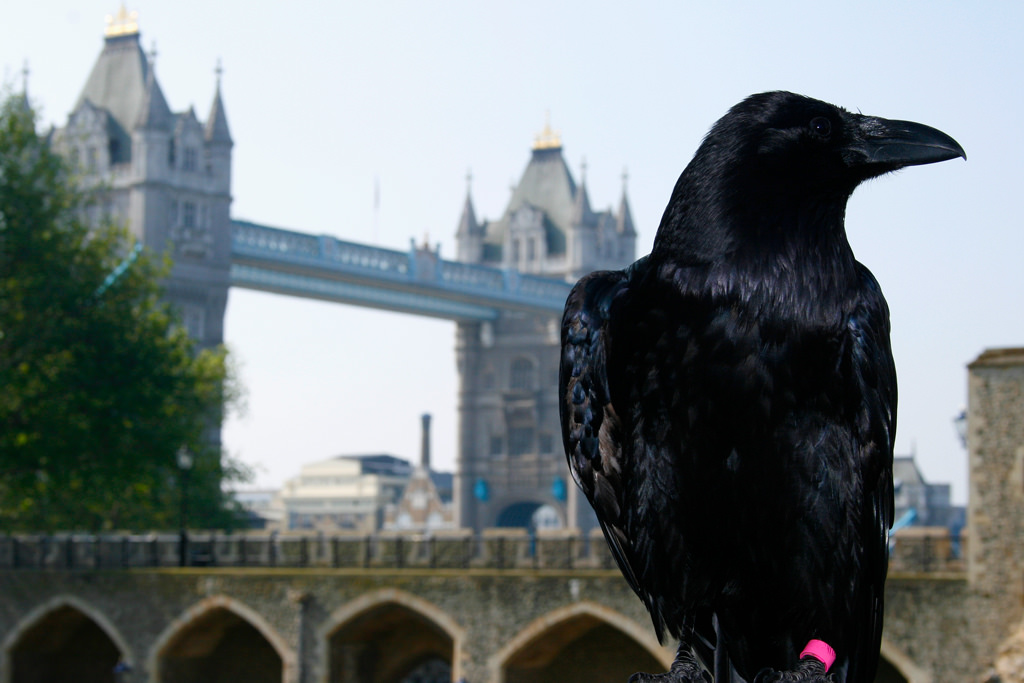
Legend has it that the Tower of London will fall if its resident ravens ever depart (photo credit: Michael Garnett, used under CC BY-NC-ND 2.0)
The public’s “love/hate” relationship with the Gypsies similarly differed between classes. In the 15th century, the castle dwellers rewarded the newly anointed “King’s Gypsies” with special rights in exchange for their valuable metal working skills, used in making the weaponry to keep the powerful in power. They were the talk of the town, with people saying “every village needs a Gypsy and a church”.
But it couldn’t last. Times were changing; industrialization and improved trade methods slowly undercut Gypsies’ exclusive professions, until the European welcome wagon to which the wandering Gypsies had become accustomed did a full 360. Expulsion became the new rule, epitomized in Stockholm’s welcoming embrace of Count Anthonius and his band of Gypsies in 1512 with free food, lodging and money until, like houseguests that overstayed their welcome, they were soon being thrown out of town and told to never return.
It was easier for the Gypsies of the Balkans, where the Gypsy metalworkers, brick-makers, cobblers and other tradesmen complimented the agricultural majority. Yet it wasn’t the same in Western Europe, where the Gypsy tradesmen found themselves confronted by the already established guild system. The old-fashioned accusations of cannibalism, disease, spies and the “j’accuse” boogie-man were a “drop in the bucket” compared to what they were to get for messing with people’s livelihood. Suddenly “every village needs a gypsy” reversed to “get out of here you crows”. Loss of income led to increased poverty and acts of desperation; Gypsies’ criminality became the story everyone talked about. Eventually “heidenjachten” (Gypsy hunts) were organized, leading to the Nazi era’s “life unworthy of living” propaganda and subsequent genocide, which Roma call “porajmos” (devouring) and which took the lives of roughly half a million Gypsies.
* * * * * *
There is an old Greco-Roman legend claiming ravens were originally all white, but couldn’t keep a secret and so were punished by Apollo by turning them black. It’s the chatty nature of the bird, and Gypsies at the market place loudly hawking their wares, that caught outsiders’ attention and ballooned into a stereotype; nevertheless, this stereotype is fact.
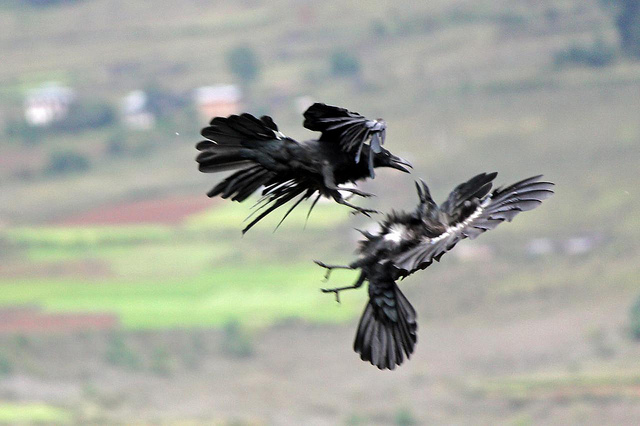
Crows fighting in midair (photo credit: Carsten ten Brink, used under CC BY-NC-ND 2.0)
The highly social crow and raven rely heavily on their voice to share information within the murder. The look-out’s loud, reverberating caw is what warns feeders of speeding cars, preventing roadkill. While the crow’s caw prevents death, it also proceeds death in their mourning. Voice again comes into play in the insistent noise they make when crows fight and seek revenge. Crows hold a grudge and their lengthy memory means they don’t forget. (If you come away from this reading with just one lesson, let it be “don’t piss off a crow”) Voice is such an important part of their behavior that sometimes one language isn’t enough; some have learned to speak human languages.
The expression “Roma strike with their tongue” is just one example of the importance a strong voice has in Gypsy society. It’s a characteristic learned as children fighting for attention in a house teeming with little brothers and sisters. Yet the value of language goes further in Roma society as the sole link between past, present and future. Roma history, customs, rituals and their laws are not found in a book; rather, these lessons are passed on orally. Newspapers don’t make their rounds in tzigania and any that do go straight to toilet paper. Gypsies collect their daily news and information through the non-stop, socially interactive “Gypsy post office” where information gets passed between communities. Often it starts its rounds at the communal well, the village social center, where the latest news is shared and jokes are told, like this one recently heard while waiting in line: “You want to know why Gypsies are so black? – Because when they were born, the stork was on holiday and brother crow made the deliveries.”

Crow and half moon (photo credit: Bryant Olsen, used under CC BY-NC 2.0)
__
Footnotes:
[1] Color-based descriptions of Roma from 15th century observers Bernhard von Breidenbach and Hermann Korner [2] Reporting on the first Gypsy arrivals in 1427, A Parisian Journal, 1405-1449, translated from the anonymous Journal d’un Bourgeois de Paris, by Janet Shirley. Oxford, at the Clarendon Press, 1968.

